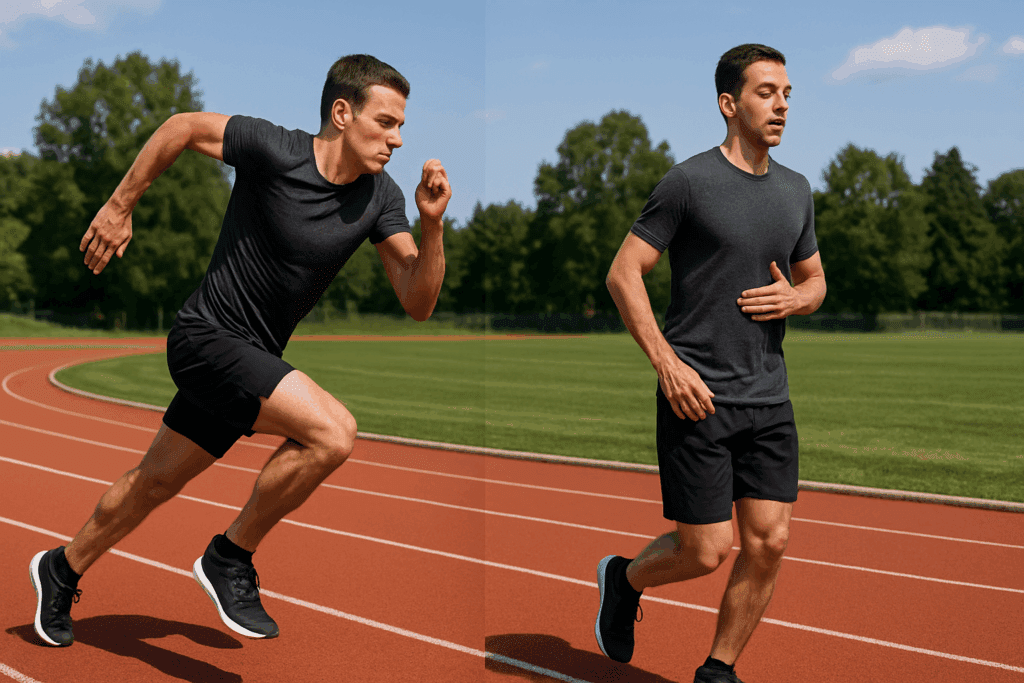Building endurance isn’t just about pushing your legs further or running longer. At the heart of stamina lies something often overlooked but critically important: breathing. For runners seeking to maximize performance and minimize fatigue, learning how to train your lungs for running is essential. Developing better breathing techniques not only enhances your aerobic capacity but can also help you stop getting out of breath when exercising. From improving lung function to mastering diaphragmatic breathing, this article explores evidence-based, practical strategies to increase your breathing capacity for running and run farther, faster, and more efficiently.
You may also like: How to Increase Stamina and Endurance Naturally: Smart Training Tips and Nutrition Habits That Support Cardiovascular Fitness

Understanding the Role of Lungs in Endurance Running
The lungs serve as the primary gateway for oxygen, fueling every movement your body makes while running. During a run, your muscles require an increased supply of oxygen to sustain prolonged activity, and your lungs must work harder to meet that demand. Understanding how to improve lung capacity for running involves recognizing the relationship between pulmonary function and physical endurance. Efficient lungs mean more oxygen is available for energy production, resulting in better performance and delayed onset of fatigue.
Oxygen uptake, or VO2 max, is commonly used to measure lung efficiency and endurance potential. Athletes with higher VO2 max levels can deliver more oxygen to their muscles and sustain activity at higher intensities. Although genetics play a role in determining baseline lung function, deliberate training can significantly enhance breathing efficiency. This underscores the importance of strategies aimed at increasing breathing capacity for running, particularly when aerobic limitations become a bottleneck for performance.
Many novice runners mistakenly assume that breathing struggles during workouts are a sign of being out of shape. However, breathlessness often stems from underdeveloped respiratory muscles and poor breathing techniques rather than a lack of cardiovascular fitness. By addressing these issues directly, you can learn how to stop getting out of breath when exercising and enjoy a more relaxed, consistent rhythm throughout your runs.

How to Train Your Lungs for Running: A Foundational Approach
Training your lungs for running involves a combination of respiratory muscle strengthening, lung expansion techniques, and endurance conditioning. Unlike skeletal muscles, which are more visibly worked during strength training, the respiratory muscles – primarily the diaphragm and intercostals – require specific exercises to become more efficient. This is where diaphragmatic breathing for runners becomes particularly relevant.
Diaphragmatic breathing, sometimes called belly breathing, encourages full expansion of the lungs by engaging the diaphragm. This method maximizes oxygen intake while minimizing energy expenditure, making it ideal for long-distance running. By training the lungs to operate more efficiently through this technique, runners can significantly improve both stamina and postural control.
Structured breath control drills can also aid in increasing breathing capacity for running. Techniques such as box breathing, rhythmic breathing (inhaling for two steps, exhaling for two), and controlled breath holds during warm-ups help improve breath awareness and respiratory resilience. These practices, when done regularly, provide tangible improvements in breathing control and oxygen utilization, both critical for endurance athletes.
Environmental adaptations, such as altitude training or using resistance devices like breathing masks, can also support lung training. These methods create hypoxic conditions, prompting the body to produce more red blood cells and strengthen respiratory muscles. While these techniques may not be suitable for everyone, especially beginners, they underscore the diverse ways to train your lungs for running and optimize aerobic efficiency.

How to Stop Getting Out of Breath When Exercising: Identifying the Root Causes
Feeling breathless during a run can be frustrating, especially when your legs feel strong, but your lungs can’t keep up. To truly address how to stop getting out of breath when exercising, it’s crucial to understand what causes this response. While physical deconditioning can play a role, it’s often a combination of poor breathing mechanics, inefficient posture, and even anxiety that triggers rapid, shallow breathing.
Shallow breathing reduces the amount of oxygen entering your bloodstream, which can cause early fatigue, dizziness, or chest tightness. When your breaths only engage the upper part of your lungs, you’re not tapping into your full respiratory capacity. This is where learning diaphragmatic breathing running techniques becomes a game-changer, as it emphasizes deep, controlled inhalations that fully oxygenate the body.
Breathing patterns are also heavily influenced by your running pace and posture. If you’re running too fast too soon, your breathing can become irregular and erratic, leading to hyperventilation. In contrast, starting slow and gradually building intensity allows your respiratory system to adapt and synchronize with your stride. Coupled with upright posture and relaxed shoulders, this pacing strategy can dramatically reduce breathlessness.
An often-overlooked factor is mental tension. Many runners unknowingly hold their breath or breathe unevenly when anxious or overly focused. Mindfulness training, meditation, and breath-focused relaxation exercises before a run can alleviate these tendencies. Developing a calm, intentional breathing rhythm can help you run longer without gasping for air, transforming your experience from one of strain to sustainability.

The Science and Technique of Diaphragmatic Breathing for Runners
Diaphragmatic breathing for runners is one of the most effective tools for boosting performance and comfort during a run. It engages the diaphragm fully, allowing the lungs to expand downward instead of relying solely on the chest and accessory muscles. This not only increases oxygen intake but also reduces tension in the upper body, leading to a smoother and more efficient stride.
To master diaphragmatic breathing running techniques, start by practicing while lying on your back. Place one hand on your chest and the other on your belly. Inhale deeply through your nose, aiming to lift the hand on your belly while keeping the chest hand still. Exhale slowly and completely. Once comfortable, transition this practice to seated positions and eventually during running, focusing on maintaining belly movement and rhythm.
Incorporating this breathing style into your runs may require time and patience. Initially, it might feel unnatural or even more tiring. However, over time, the diaphragm becomes stronger and more responsive, enabling deeper, slower breaths even under physical stress. As your body adapts, you’ll find that your breathing stabilizes and your endurance improves.
Advanced runners can take diaphragmatic training further by incorporating it with cadence breathing. This method coordinates breath with foot strikes to create a rhythmic pattern, such as inhaling for three steps and exhaling for two. This synchronization promotes a balanced workload between both sides of the body and helps prevent muscle fatigue and injury.
Breath training apps and biofeedback tools are also gaining popularity for teaching diaphragmatic breathing techniques. These tools offer real-time metrics on breathing rate, volume, and consistency, making it easier for runners to monitor progress and adjust techniques. With consistent effort, diaphragmatic breathing becomes second nature, offering a sustainable path to greater running efficiency.

Practical Strategies to Improve Lung Capacity for Running
If you want to know how to improve lung capacity for running, it helps to take a multifaceted approach. Physical training, breathwork, and recovery all play vital roles. First, interval training can significantly enhance aerobic and anaerobic thresholds. Alternating between short bursts of high-intensity effort and recovery phases challenges the lungs to adapt and expand their functional capacity. Over time, this results in better oxygen uptake and utilization.
Swimming and cycling also serve as excellent cross-training methods for boosting lung power. These activities involve sustained breath control and muscle engagement, which translate well to running. Because swimming requires coordination between breath and movement, it especially complements runners aiming to increase breathing capacity for running through controlled exhalation and timing.
Respiratory muscle training (RMT) is another powerful, research-backed method for lung enhancement. Devices designed to increase resistance during inhalation can help strengthen the diaphragm and intercostal muscles. Studies show that RMT improves endurance in both elite and recreational athletes by reducing the perceived effort of breathing and increasing oxygen efficiency. When combined with consistent running, this method can substantially improve how to train your lungs for running in a systematic way.
Diet and hydration also impact respiratory performance. Staying well-hydrated helps maintain mucus membrane function in the lungs, allowing for smoother airflow. Nutrients such as antioxidants, iron, and omega-3 fatty acids support red blood cell function and reduce inflammation, contributing to more effective oxygen transport. While dietary changes alone won’t replace physical training, they form an essential part of a holistic strategy.
Sleep and recovery further influence your lungs’ ability to perform. During sleep, respiratory muscles regenerate, and the body undergoes processes that improve cardiovascular and pulmonary efficiency. Prioritizing rest ensures that your lungs operate at full potential and are not compromised by cumulative fatigue or stress.

How to Increase Breathing Capacity for Running With Mindful Movement
Breathing capacity isn’t solely a physiological issue; it’s also behavioral and neurological. Mindful movement practices, such as yoga and tai chi, can significantly support efforts to increase breathing capacity for running by cultivating better body awareness, postural alignment, and breath control. These practices encourage deep, rhythmic breathing patterns and emphasize the mind-body connection, both of which are essential for endurance performance.
Yoga, in particular, integrates pranayama (breath control) techniques that expand lung capacity and promote diaphragmatic use. Practices like alternate nostril breathing, breath retention, and deep belly breathing train the lungs to manage volume and flow more efficiently. These techniques also reduce anxiety, which can contribute to better control over breathing during high-intensity efforts.
Postural awareness is another key benefit. When the spine is aligned and the chest is open, the lungs can expand more freely. Poor posture – especially slouching – compresses the diaphragm and limits oxygen intake. Training yourself to maintain a tall, relaxed posture during running allows for greater lung expansion and improved airflow.
Even the practice of mindful walking, where breath is synchronized with foot placement and body awareness, can serve as a low-impact way to condition the lungs. Walking meditations or slow hikes in nature with focused breathing can help develop the kind of respiratory control needed for more strenuous efforts. It’s these low-stakes environments that often offer the best foundation for behavioral changes in breathwork.
Learning how to increase breathing capacity for running is not only about pushing physical limits but also about cultivating a new awareness of how your body uses oxygen. When breath becomes conscious and intentional, every step gains purpose, and each run becomes an opportunity for growth.
Bringing It All Together: Integrating Breathing Into Your Running Practice
The most powerful training programs are the ones that combine strategy, intention, and adaptability. To stop getting out of breath when exercising and extend your endurance, it’s essential to incorporate breath training into your overall running plan. Start by setting small, manageable goals. Practice diaphragmatic breathing during your warm-ups and cooldowns. Experiment with different rhythms to find what suits your pace. Track your progress not just by speed or distance, but by how steady and efficient your breathing feels over time.
Incorporating structured intervals specifically designed to test and expand your lung capacity can make your training more dynamic. For example, alternating between 30 seconds of sprinting and 90 seconds of recovery walking encourages your respiratory system to adapt to varying oxygen demands. As you progress, try incorporating breath holds or nose-only breathing drills to further stimulate lung efficiency.
Don’t forget to listen to your body. If you experience excessive breathlessness, dizziness, or discomfort, it may signal overexertion or improper form. Returning to the basics – proper posture, gradual progression, and consistent breathwork – ensures that improvements are sustainable and health-promoting.
Journaling your experience can also provide insights. Note how certain breathing strategies affect your pace, recovery, and mental clarity. Over time, you’ll be able to identify what methods offer the greatest benefit and tailor your training accordingly. This reflective process enhances self-awareness, motivation, and long-term commitment.
Frequently Asked Questions: Lung Training and Breathing Strategies for Runners
1. Can you actually increase your lung size, or is it more about breathing efficiency?
While the physical size of your lungs is largely determined by genetics and doesn’t significantly change with training, the efficiency with which you use your lungs can improve dramatically. Learning how to train your lungs for running involves expanding your respiratory muscles’ strength and teaching your body to optimize oxygen uptake and carbon dioxide expulsion. It’s more about improving the elasticity of lung tissue, strengthening the diaphragm, and increasing the coordination between breath and movement. As your breathing efficiency improves, so does your capacity for endurance. This is why diaphragmatic breathing running techniques are often prioritized by elite athletes seeking marginal gains in performance.
2. Why does anxiety worsen breathlessness during runs, and how can breathing techniques help?
Anxiety triggers the body’s stress response, which often includes rapid, shallow breathing that further decreases oxygen intake. This reaction creates a feedback loop, making you feel more breathless and increasing panic. When you learn how to stop getting out of breath when exercising, you begin to notice that mental control over breath can be just as vital as physical conditioning. Diaphragmatic breathing for runners offers a grounding technique that calms the nervous system while also promoting deeper oxygen exchange. This dual benefit helps runners stay composed during challenging portions of a run, reducing anxiety-induced breathlessness.
3. How does altitude training compare to traditional methods for increasing breathing capacity?
Altitude training creates a hypoxic environment, which forces the body to adapt by producing more red blood cells to carry oxygen more efficiently. While effective, it isn’t necessary for every runner, especially when there are alternative ways to improve lung function. For those unable to train at elevation, learning how to increase breathing capacity for running can be achieved through breath-hold exercises, resistance-based respiratory devices, and interval running protocols. These methods simulate the benefits of altitude training without leaving sea level. Understanding how to train your lungs for running in diverse environments allows runners to enhance performance regardless of geography.
4. Are there specific signs that indicate poor breathing technique during a run?
Yes, frequent yawning, side stitches, and shoulder tension during a run can indicate shallow or irregular breathing. Many runners aren’t aware that they revert to chest breathing, especially when fatigued or pushing their pace. One way to detect poor technique is by checking if your breathing becomes louder or more erratic during light effort. Learning how to improve lung capacity for running involves training yourself to recognize these signs early and recalibrate your breathing. Through consistent practice with diaphragmatic breathing for runners, these disruptions can be minimized, resulting in smoother, more rhythmic runs.
5. What role does body positioning play in breathing efficiency during running?
Posture significantly affects how well your lungs can expand during exercise. When you slouch or collapse forward at the waist, you compress the diaphragm and limit its range of motion. Keeping an upright, relaxed posture opens up your chest cavity and allows for fuller lung expansion. Runners who understand how to stop getting out of breath when exercising often cite posture correction as a breakthrough technique. Combining good form with diaphragmatic breathing running practices enables maximum air intake with minimal muscular effort.
6. Can breathing techniques be adapted for sprinting as well as distance running?
Absolutely. While endurance runners often focus on steady, sustained breathing, sprinters benefit from short, explosive bursts of breath that complement quick muscle contractions. Even in anaerobic efforts, understanding how to train your lungs for running can improve oxygen efficiency between intervals and enhance recovery. Sprinters who adopt diaphragmatic control often experience better stability and reduced energy loss due to improved core engagement. Adapting diaphragmatic breathing for runners across disciplines simply requires adjusting cadence and breath timing to match the intensity and duration of the effort.
7. How long does it typically take to see improvements in lung capacity with consistent practice?
Results vary based on consistency, baseline fitness, and the methods used, but many runners report noticeable improvements within three to four weeks of targeted breath training. Those who learn how to improve lung capacity for running through structured breathing drills often experience better endurance and less perceived effort relatively quickly. Devices for respiratory muscle training can accelerate these gains, particularly when used in conjunction with regular aerobic conditioning. The key is to maintain regular, progressive practice and gradually layer in more advanced techniques. Knowing how to increase breathing capacity for running is only the beginning—adherence is what produces lasting change.
8. Are there any risks associated with overtraining the respiratory system?
Yes, just like any other muscle group, the respiratory muscles can be overworked, especially if you suddenly increase training intensity or use resistance-based devices excessively. Symptoms of overtraining may include chest tightness, prolonged fatigue, or even light-headedness during normal workouts. It’s important to introduce techniques gradually when learning how to train your lungs for running, particularly for beginners or those with underlying respiratory conditions. Always listen to your body, and consider consulting a medical or fitness professional before incorporating advanced breath-control tools. Proper technique, rest, and moderation ensure that your journey toward how to improve lung capacity for running remains both effective and safe.
9. Can music or metronomes help synchronize breathing for better performance?
Yes, music and metronomes can be powerful tools for creating rhythm, which is central to breath coordination during running. Matching your breathing to a consistent beat helps establish patterns, reduces variability, and promotes diaphragmatic engagement. Runners exploring how to stop getting out of breath when exercising often find that setting a playlist with a tempo aligned to their running pace can reinforce smoother, more efficient breathing cycles. This external cueing can also assist in transitioning to cadence-based breathing, where each inhale and exhale matches a specific number of steps. Whether using music or a metronome, these tools are valuable for reinforcing how to increase breathing capacity for running through behavioral feedback.
10. How can group training environments impact breathing development?
Training in a group setting can positively or negatively impact breathing habits depending on how mindful you are. On the one hand, the shared energy and pacing can encourage greater effort and longer runs. On the other hand, if you’re constantly trying to match someone else’s rhythm, it can disrupt your natural breathing cadence and increase breathlessness. Developing self-awareness is critical when learning how to stop getting out of breath when exercising in social settings. Integrating diaphragmatic breathing for runners into group runs takes conscious effort, but it can improve focus, create internal consistency, and reduce the peer pressure that often leads to overexertion. Ultimately, being able to breathe independently of external pressures is a sign of true respiratory mastery.
Conclusion: Breathing Better to Run Stronger and Longer
Endurance is not merely a test of muscle strength or cardiovascular stamina; it’s a reflection of how well you breathe. Learning how to train your lungs for running unlocks a new level of performance and comfort, allowing you to engage in longer runs with greater ease and confidence. Through techniques like diaphragmatic breathing for runners, structured breath training, and mindful movement practices, you can improve lung capacity for running in ways that enhance both your physical and mental resilience.
Whether you’re a novice aiming to stop getting out of breath when exercising or an experienced runner looking to increase breathing capacity for running, the tools are within reach. By committing to these practices, you’re not just improving your athletic potential—you’re embracing a more holistic, efficient, and empowered approach to endurance. In the rhythm of your breath lies the strength of your stride, and with every conscious inhale and exhale, you move closer to your peak performance.
Was this article helpful? Don’t let it stop with you. Share it right now with someone who needs to see it—whether it’s a friend, a colleague, or your whole network. And if staying ahead on this topic matters to you, subscribe to this publication for the most up-to-date information. You’ll get the latest insights delivered straight to you—no searching, no missing out.
Further Reading:
Breathing Exercises to Increase Lung Capacity

